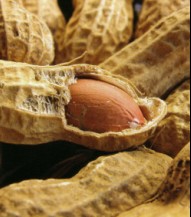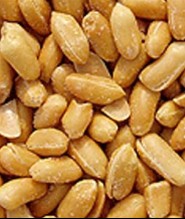1. How the peanut grows.
The peanut is unusual because it flowers above the ground, but fruits below the ground. Typical misconceptions of how peanuts grow place them on trees, like walnuts or pecans, or growing as a part of a root like potatoes. Peanut seeds (kernels) grow into a green oval-leafed plant about 18 inches tall, which develop delicate yellow flowers around the lower portion of the plant. The flowers pollinate themselves, and then lose their petals as the fertilized ovary begins to enlarge. The budding ovary grows down and away from the plant forming a small stem or "peg", that extends to the soil. The peanut embryo is in the tip of the peg, which penetrates the soil. The embryo turns horizontal to the soil surface and begins to mature, taking the form of the peanut. From planting to harvesting the growing cycle takes about four to five months, depending on the variety. The peanut is a nitrogen-fixing plant; its roots form nodules, which absorb nitrogen from the air and provide enrichment and nutrition to the plant and soil.
2. Are there different types of peanuts?
Yes. There are mainly three types of peanuts grown in the United States- Virginias, Runners and Spanish peanuts. Virginias are often called cocktail nuts and are considered large-kerneled. Medium-sized kernels are called Runners and small-sized kernels are called Spanish peanuts. A fourth type, Valencia peanuts, are grown less frequently in the US and are characterized by three or four small kernels in a long shell.
3. Are peanuts legumes?
Yes. Peanuts, along with beans and peas, belong to the single plant family, Leguminosae. Legumes are edible seeds enclosed in pods. As a group, they provide the best source of concentrated protein in the plant kingdom. While their physical structure and nutritional benefits more closely resemble that of other legumes, their use in diets and cuisines more closely resembles that of nuts.
4. Where did peanuts originate?
The peanut plant is thought to have originated in Brazil or Peru. Portuguese explorers transplanted it to Africa, and from there it was brought to America as an inexpensive, high-protein staple, later to be consumed by soldiers during the Civil War.
5. Why are peanuts sometimes referred to as "ground nuts?"
Peanuts actually grow underground, as opposed to nuts like walnuts, almonds, etc. that grow on trees (and are sometimes referred to as "tree nuts").
6. Where are peanuts grown in China?
Mainly in these five states: Shandong, Liaoning, Henan, Hebei, Jiangxi.



